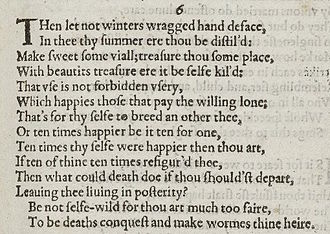Poem by William Shakespeare
| «» Sonnet 6 | |||||||
|---|---|---|---|---|---|---|---|
 Sonnet 6 in the 1609 Quarto Sonnet 6 in the 1609 Quarto | |||||||
| |||||||
Sonnet 6 is one of 154 sonnets written by the English playwright and poet William Shakespeare. It is a procreation sonnet within the Fair Youth sequence. The sonnet continues Sonnet 5, thus forming a diptych. It also contains the same distillatory trope featured in Sonnet 54, Sonnet 74 and Sonnet 119.
Structure
Sonnet 6 is an English or Shakespearean sonnet, constructed of three quatrains followed by a couplet, all in iambic pentameter, with the typical rhyme scheme of the English sonnet, ABAB CDCD EFEF GG. Most of the poem exemplifies the regular metrical alternation characteristic of iambic pentameter, as can be seen in the couplet:
× / × / × / × / × / Be not self-willed, for thou art much too fair × / × / × / × / × / To be death's conquest and make worms thine heir. (6.13-14)
- / = ictus, a metrically strong syllabic position. × = nonictus.
However, both these lines allow an alternative scansion, which may highlight a parallelism between "self-willed" and "death's conquest":
× × / / × / × / × / Be not self-willed, for thou art much too fair × × / / × / × / × / To be death's conquest and make worms thine heir. (6.13-14)
Analysis
The opening line of this sonnet leads directly from the end of Sonnet 5, as though the two poems were intended as one, itself perhaps a reference to the idea of pairing through marriage that shapes the first 17 sonnets. The first line, “Then let not winters wragged hand deface,” also parallels Sonnet 64’s opening, “When I haue seene by times fell hand defaced.”
The third line's sweet "vial" refers to the distillation of perfume from petals mentioned in Sonnet 5, but is now directly explained and expanded as an image of sexual impregnation in order to produce children. In addition to the glass beaker, "vial" was also traditionally used of the womb: the OED cites John Lydgate’s invocation to the Blessed Virgin, “O glorious viole, O vitre inviolate.”
The language of accounting is repeated from Sonnet 4. The image of "usury" refers to replication of the invested "essence" in offspring, in the same way that money earns interest. The propagation of children can never be exploitative. Shakespeare's own father had been accused in 1570 of usury, of charging 20% and 25% interest. Elizabethan divines preached uncompromisingly against usury in principle but often tolerated it in practice: the Usury Act 1571 (13 Eliz. 1. c. 8), while providing punishments for usury above and below 10%, unwittingly legitimized a standard interest rate of 10%. Thus, Shakespeare plays with tens, and a tenfold return on the investment is to be desired.
References
- Pooler, C Knox, ed. (1918). The Works of Shakespeare: Sonnets. The Arden Shakespeare . London: Methuen & Company. OCLC 4770201.
- ^ Larsen, Kenneth J. "Sonnet 6". Essays on Shakespeare's Sonnets. Retrieved 18 November 2014.
Further reading
- Baldwin, T. W. On the Literary Genetics of Shakspeare's Sonnets. Urbana: University of Illinois Press, 1950.
- Hubler, Edwin. The Sense of Shakespeare's Sonnets. Princeton: Princeton University Press, 1952.
- First edition and facsimile
- Shakespeare, William (1609). Shake-speares Sonnets: Never Before Imprinted. London: Thomas Thorpe.
- Lee, Sidney, ed. (1905). Shakespeares Sonnets: Being a reproduction in facsimile of the first edition. Oxford: Clarendon Press. OCLC 458829162.
- Variorum editions
- Alden, Raymond Macdonald, ed. (1916). The Sonnets of Shakespeare. Boston: Houghton Mifflin Harcourt. OCLC 234756.
- Rollins, Hyder Edward, ed. (1944). A New Variorum Edition of Shakespeare: The Sonnets . Philadelphia: J. B. Lippincott & Co. OCLC 6028485. — Volume I and Volume II at the Internet Archive
- Modern critical editions
- Atkins, Carl D., ed. (2007). Shakespeare's Sonnets: With Three Hundred Years of Commentary. Madison: Fairleigh Dickinson University Press. ISBN 978-0-8386-4163-7. OCLC 86090499.
- Booth, Stephen, ed. (2000) . Shakespeare's Sonnets (Rev. ed.). New Haven: Yale Nota Bene. ISBN 0-300-01959-9. OCLC 2968040.
- Burrow, Colin, ed. (2002). The Complete Sonnets and Poems. The Oxford Shakespeare. Oxford: Oxford University Press. ISBN 978-0192819338. OCLC 48532938.
- Duncan-Jones, Katherine, ed. (2010) . Shakespeare's Sonnets. Arden Shakespeare, third series (Rev. ed.). London: Bloomsbury. ISBN 978-1-4080-1797-5. OCLC 755065951. — 1st edition at the Internet Archive
- Evans, G. Blakemore, ed. (1996). The Sonnets. The New Cambridge Shakespeare. Cambridge: Cambridge University Press. ISBN 978-0521294034. OCLC 32272082.
- Kerrigan, John, ed. (1995) . The Sonnets ; and, A Lover's Complaint. New Penguin Shakespeare (Rev. ed.). Penguin Books. ISBN 0-14-070732-8. OCLC 15018446.
- Mowat, Barbara A.; Werstine, Paul, eds. (2006). Shakespeare's Sonnets & Poems. Folger Shakespeare Library. New York: Washington Square Press. ISBN 978-0743273282. OCLC 64594469.
- Orgel, Stephen, ed. (2001). The Sonnets. The Pelican Shakespeare (Rev. ed.). New York: Penguin Books. ISBN 978-0140714531. OCLC 46683809.
- Vendler, Helen, ed. (1997). The Art of Shakespeare's Sonnets. Cambridge, Massachusetts: The Belknap Press of Harvard University Press. ISBN 0-674-63712-7. OCLC 36806589.
External links
 Works related to Sonnet 6 (Shakespeare) at Wikisource
Works related to Sonnet 6 (Shakespeare) at Wikisource- An analysis and paraphrase of the sonnet
- Commentary
| Shakespeare's sonnets | ||||||||
|---|---|---|---|---|---|---|---|---|
| "Fair Youth" sonnets |
|  | ||||||
| "Dark Lady" sonnets |
| |||||||
